Sunday, August 28, 2011
Hiatus
I'll be on hiatus for a week as I travel to conduct some interviews for a book. Back by the weekend with posts on the Premocar, GV Electric trucks and Aeromoto scooters. Stay tuned.
Sunday, August 21, 2011
GMC Electric Trucks
During my daily scroll through Jesse's Just a Car Guy blog, I came across this image that he'd hoovered up from The Old Motor site:

The lads at the American Truck Historical Society (which I belonged to for most of the '80s) had pegged it as a 1913-14 GMC Electric. I first became aware of GMC Electrics from Gini Rice's 1971 Relics of the Road series, Volume One, GMC Gems, 1900-1950, although she only had one picture and scant information:

From Hemmings blog.
John M. Lansden co-founded the Lansden Company in New Jersey in early 1904 with financial help from Thomas Edison. Edison acquired control of the company in 1908 and sold it 1912. The company declared bankruptcy in 1913 and was absorbed by the Mack Truck Company. During its eight year tenure, the Lansden Company built some 2,000 electric trucks and delivery wagons, along with an unknown number of a two-seat electric roadster, the Electrette:

1906 Lansden Electrette. From Just a Car Guy blog.
Lansden left his namesake company in 1911 - shortly before Edison sold it - to start up and manage the electric truck and bus section the newly formed General Motors Truck Company. The whole Lansden Company story will be told in another post another day.
GMC Truck Historian Donald E. Meyer contends that the GMC owned Rapid Motor Vehicle Company (fully acquired in 1909) offered the new electric trucks first, followed by GMC proper, but to date no pictures of a Rapid Electric of this vintage have surfaced.
GMC Electric truck production lasted from 1912 to 1917, with nine standard capacities being offered ranging between half-ton and six-ton. A January 23, 1913 New York Times ad claimed 42 GMC models - 25 Electric and 17 gasoline. At the 1913 New York Truck Show, the GMC Electric Truck display was at the Grand Central Palace, while the Gasoline Truck display was at Madison Square Garden. 1,200 to 1,300 Electrics were built over the five year period. Compare that with the output of just one of GMC's competitors, the General Vehicle Company (GeVeCo) - by 1915 New York City alone had 2,000 of GeVeCo's GV Electric trucks, and that represented more than 25% of all trucks of all types working daily in the city:

While GMC Electric was bragging about the Ebling Brewery using two of their product, rival brewer Jacob Ruppert had 112 GV Electrics in operation. From the June 26, 1913 issue of The New York Times.
More on the General Vehicle Company later - for now see the post here.
In 1914, GMC Electrics represented just over 22% of GMC truck and bus production. By the next year that figure was cut by more than half, and by 1916 it was down to just over 3%. Only one GMC Electric left the assembly line the final year of production.

GMC Electric used by City Board of Health. From the December, 1916 issue of Municipal Engineering journal.
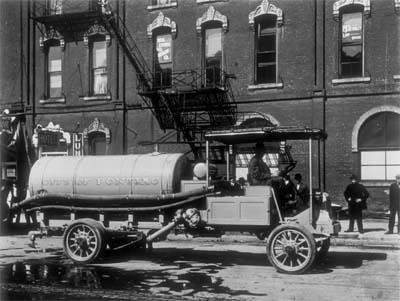
1912 GMC Electric street flusher. From the GM Heritage Center.

1913 GMC Electric transfer van. From the GM Heritage Center.

Taken August 1, 1916. GMC Electric truck delivering six C-3 Hughes Electric Ranges to the Wertenbaker Apartments in Charlottesville. From the Albemarle Charlottesville Historical Society.

Calgary Water Work's 1914 GMC Electric truck replaces at least eight draft horses. From the American Truck Historical Society website.

1912 2-ton GMC Electric truck used on the farm of Boston's Edison Light and Power. Original caption:"Truck on Electric Farm - On the Electric Farm of the Boston, Mass., Edison Company electricity does everything. It cuts the fodder, milks the cows, washes the dishes, pumps the water, churns the butter and finally takes the products of the farm to the city in a G.M.C. truck." From the June 20, 1912 issue of The Automobile magazine.
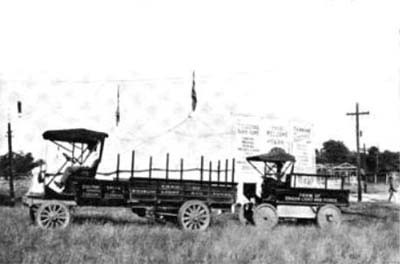
Same 1912 2-ton GMC Electric truck as above, with a quarter-ton Walker Vehicle Company electric truck (also owned by the farm) behind it. From the October, 1912 issue of the General Electric Review.

1912 GMC Electric Model 2-E in Philadelphia (?). Body possibly made by Bethlehem Steel. From the JalopyJournal.com.
In 1912 GMC Electric had entered an already saturated market and simply could not catch up. By 1917 they had wisely chosen to concentrate on the ultimately dominate gasoline truck.
These are all of the GMC Electric photos I could find. If you know of any others, please let me know where to find them.

The lads at the American Truck Historical Society (which I belonged to for most of the '80s) had pegged it as a 1913-14 GMC Electric. I first became aware of GMC Electrics from Gini Rice's 1971 Relics of the Road series, Volume One, GMC Gems, 1900-1950, although she only had one picture and scant information:

John M. Lansden co-founded the Lansden Company in New Jersey in early 1904 with financial help from Thomas Edison. Edison acquired control of the company in 1908 and sold it 1912. The company declared bankruptcy in 1913 and was absorbed by the Mack Truck Company. During its eight year tenure, the Lansden Company built some 2,000 electric trucks and delivery wagons, along with an unknown number of a two-seat electric roadster, the Electrette:

Lansden left his namesake company in 1911 - shortly before Edison sold it - to start up and manage the electric truck and bus section the newly formed General Motors Truck Company. The whole Lansden Company story will be told in another post another day.
GMC Truck Historian Donald E. Meyer contends that the GMC owned Rapid Motor Vehicle Company (fully acquired in 1909) offered the new electric trucks first, followed by GMC proper, but to date no pictures of a Rapid Electric of this vintage have surfaced.
GMC Electric truck production lasted from 1912 to 1917, with nine standard capacities being offered ranging between half-ton and six-ton. A January 23, 1913 New York Times ad claimed 42 GMC models - 25 Electric and 17 gasoline. At the 1913 New York Truck Show, the GMC Electric Truck display was at the Grand Central Palace, while the Gasoline Truck display was at Madison Square Garden. 1,200 to 1,300 Electrics were built over the five year period. Compare that with the output of just one of GMC's competitors, the General Vehicle Company (GeVeCo) - by 1915 New York City alone had 2,000 of GeVeCo's GV Electric trucks, and that represented more than 25% of all trucks of all types working daily in the city:

More on the General Vehicle Company later - for now see the post here.
In 1914, GMC Electrics represented just over 22% of GMC truck and bus production. By the next year that figure was cut by more than half, and by 1916 it was down to just over 3%. Only one GMC Electric left the assembly line the final year of production.








In 1912 GMC Electric had entered an already saturated market and simply could not catch up. By 1917 they had wisely chosen to concentrate on the ultimately dominate gasoline truck.
These are all of the GMC Electric photos I could find. If you know of any others, please let me know where to find them.
Tuesday, August 16, 2011
Last Singer/Celebrity post, I promise
Revised 2/11/12

Howard Carter (played by Richard Long) helps Susie Ward (Mamie Van Doren) adjust the windshield of her Singer Roadster at a made-for-the-movies gas station in the 1953 film The All American. From emonds.com forums. Photo may be by Frank Worth, whose collection is handled by Capital Art.
The early fifties was the time period that the Singer distributor in America, Bill Vaughan, sought to boost publicity by posing celebrities with the cars. In this instance he even got a product placement in the only movie in which Mamie Van Doren and Richard Long (below) ever appeared together.
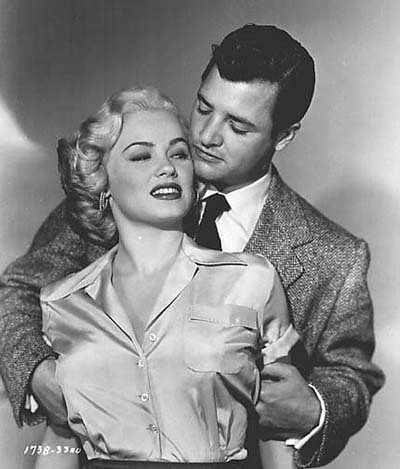
Publicity photo of Mamie Van Doren and Richard Long, from the 1953 film The All American. From Stirred, Straight Up, with a Twist blog.
The only other American made movie that I can think of that had a Singer Roadster in it - however briefly - was the original 1955 The Fast and the Furious, which featured a short scene with a privately owned Singer 4AD 1500, shown here being sandwiched in by a 1952 Kaiser Manhattan in front, and a 1952-3 Nash Healey in the rear:

From Internet Movie Cars Database.

The early fifties was the time period that the Singer distributor in America, Bill Vaughan, sought to boost publicity by posing celebrities with the cars. In this instance he even got a product placement in the only movie in which Mamie Van Doren and Richard Long (below) ever appeared together.

The only other American made movie that I can think of that had a Singer Roadster in it - however briefly - was the original 1955 The Fast and the Furious, which featured a short scene with a privately owned Singer 4AD 1500, shown here being sandwiched in by a 1952 Kaiser Manhattan in front, and a 1952-3 Nash Healey in the rear:

Monday, August 15, 2011
Frank, Sammy, Marilyn and the Singer
Revised 2/9/12; 2/10/12; 2/11/12

Scan of front cover of the June 19, 1953 issue of Motor World magazine.
No, not that Frank, but rather the famous photographer Frank Worth. And by Singer I mean the roadster again.
Frank Worth had the job to the shoot some Singer/celebrity publicity shots, as well as the cover car for the June 19, 1953 issue of the biweekly Motor World magazine. Back then most magazines had a 90 day publishing cycle - in other words, the issue you put to bed today would hit the newsstands in three months. Biweeklies had a tighter cycle, so the latest Worth could turn in his assignment for the June issue was about mid-April.
The subject car was to be the new Singer SM 1500C Roadster. Since Worth was also on contract to 20th Century Fox Studios to shoot stills of one of their current productions, he used some down time between shots to do the car shoot in the studio's parking lot. He could even bring along some up-and-coming starlet to spice up the cover shoot and gin up some publicity for the studio's current effort. A real twofer.
He first shot the Singer possibly belonging to either Donald O'Connor or Debbie Reynolds (see More Scooters, Another Singer post below), but couldn't use it for the cover shot because the custom paint job wouldn't cut it as being representative of a factory-fresh car. Instead he used a brand-new Singer SM 1500C Roadster supplied by Vaughan-Singer Motors of Hollywood, and invited Sammy Davis Jr. over for more celebrity shots. Sammy, an enthusiastic amateur photographer and camera collector in his own right, showed up with his best friend and business partner Arthur Silber in tow. Lo and behold, the up-and-coming starlet Worth brought along wasn't a mere starlet after all, but Marilyn Monroe, who was already rocketing to major stardom. This would cause just about any red-blooded American male to jump for joy:
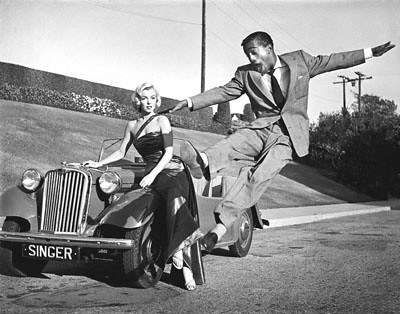
Compare the dress on the magazine cover with the one in this scene from the movie How to Marry a Millionaire:

A screen capture from the Technicolor movie:
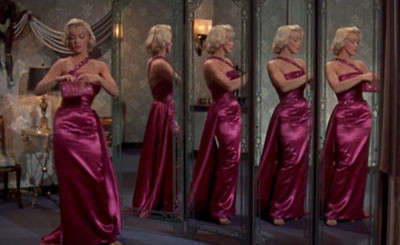
That movie, on which filming had begun in early April (and premiered in November!), was the one for which Worth was shooting the publicity stills. He certainly had spare time between scenes, since there were over 250 different shots in the movie. By-the-by, this was the first ever movie to be filmed in CinemaScope, but it wasn't released until the second one, The Robe, had been released.
Here are some of the shots that didn't make the cut for the cover:

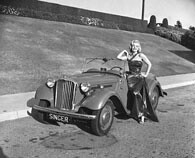






That last color one appears to have been shot by Sammy, and shows the car to be red.
Frank Worth finished the cover shoot, then continued to take publicity pictures, including this one of Marilyn signing photos for Sammy and Art:

Incidentally, here is one of those studio "head shots" of Marilyn that are on the hood in the above picture:

One of Marilyn Monroe's studio headshots from 1953. Autographed to and owned by Arthur Silber.
She signed it "To Art, Love and kisses, Marilyn Monroe" Art kept it.
The scenes where Marilyn's character Pola Debevoise is wearing this dress must have wrapped already, otherwise I don't think she'd be allowed to sit on the grass in it. Here she is posing for Frank Worth, but Sammy Davis Jr. took this shot:

Here is the shot that Worth took - it's of Sammy taking the picture of Marilyn:

Next Marilyn posed next to Frank Worth's rare 1951 Riley RMD DHC (drop-head-coupe)—one of about 500 made for that particular model:
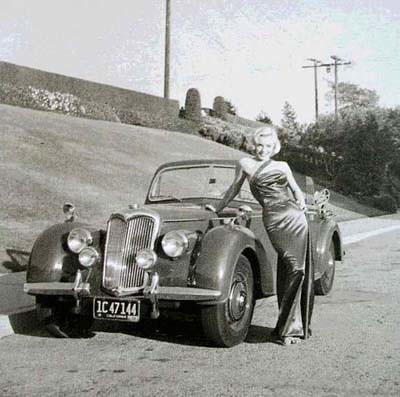
Marilyn Monroe posing with Frank Worth's 1951 Riley RMD DHC. Photo thought to be by Sammy Davis Jr.
Sammy shoots Marilyn as she poses for Worth:

The picture Worth took:

In 2007 Christies's auctioned off an original, numbered (29/245), limited edition print of this black and white photograph (with photographer's stamp) with a pre-auction estimate of $1,000 - $1,500. It sold for $2,280.
Then, to wrap things up, Sammy took a picture of Worth and Marilyn together next to Worth's car:

So Singer got its hot little roadster graced by a hot star on the cover of an important (then) auto magazine; Marilyn, and to a lesser degree, Donald O'Connor, Debbie Reynolds and Sammy Davis Jr. got some free publicity; 20th Century Fox got its movie promoted five months before it opened; and Frank Worth got paid twice. Nice work if you can get it. I'm available, No, seriously, I'm available.
Best quote from the movie How to Marry a Millionaire: Lauren Bacall's character, Schatze, says, "I've always liked older men... Look at that old fellow what's-his-name in The African Queen. Absolutely crazy about him."
All photos by Frank Worth unless otherwise noted. Frank Worth’s collection is now exclusively available fromGuy Hepner. Apparently the collection is now handled by Capital Art.

No, not that Frank, but rather the famous photographer Frank Worth. And by Singer I mean the roadster again.
Frank Worth had the job to the shoot some Singer/celebrity publicity shots, as well as the cover car for the June 19, 1953 issue of the biweekly Motor World magazine. Back then most magazines had a 90 day publishing cycle - in other words, the issue you put to bed today would hit the newsstands in three months. Biweeklies had a tighter cycle, so the latest Worth could turn in his assignment for the June issue was about mid-April.
The subject car was to be the new Singer SM 1500C Roadster. Since Worth was also on contract to 20th Century Fox Studios to shoot stills of one of their current productions, he used some down time between shots to do the car shoot in the studio's parking lot. He could even bring along some up-and-coming starlet to spice up the cover shoot and gin up some publicity for the studio's current effort. A real twofer.
He first shot the Singer possibly belonging to either Donald O'Connor or Debbie Reynolds (see More Scooters, Another Singer post below), but couldn't use it for the cover shot because the custom paint job wouldn't cut it as being representative of a factory-fresh car. Instead he used a brand-new Singer SM 1500C Roadster supplied by Vaughan-Singer Motors of Hollywood, and invited Sammy Davis Jr. over for more celebrity shots. Sammy, an enthusiastic amateur photographer and camera collector in his own right, showed up with his best friend and business partner Arthur Silber in tow. Lo and behold, the up-and-coming starlet Worth brought along wasn't a mere starlet after all, but Marilyn Monroe, who was already rocketing to major stardom. This would cause just about any red-blooded American male to jump for joy:

Compare the dress on the magazine cover with the one in this scene from the movie How to Marry a Millionaire:

A screen capture from the Technicolor movie:

That movie, on which filming had begun in early April (and premiered in November!), was the one for which Worth was shooting the publicity stills. He certainly had spare time between scenes, since there were over 250 different shots in the movie. By-the-by, this was the first ever movie to be filmed in CinemaScope, but it wasn't released until the second one, The Robe, had been released.
Here are some of the shots that didn't make the cut for the cover:








That last color one appears to have been shot by Sammy, and shows the car to be red.
Frank Worth finished the cover shoot, then continued to take publicity pictures, including this one of Marilyn signing photos for Sammy and Art:

Incidentally, here is one of those studio "head shots" of Marilyn that are on the hood in the above picture:

She signed it "To Art, Love and kisses, Marilyn Monroe" Art kept it.
The scenes where Marilyn's character Pola Debevoise is wearing this dress must have wrapped already, otherwise I don't think she'd be allowed to sit on the grass in it. Here she is posing for Frank Worth, but Sammy Davis Jr. took this shot:

Here is the shot that Worth took - it's of Sammy taking the picture of Marilyn:

Next Marilyn posed next to Frank Worth's rare 1951 Riley RMD DHC (drop-head-coupe)—one of about 500 made for that particular model:

Sammy shoots Marilyn as she poses for Worth:

The picture Worth took:

Then, to wrap things up, Sammy took a picture of Worth and Marilyn together next to Worth's car:

So Singer got its hot little roadster graced by a hot star on the cover of an important (then) auto magazine; Marilyn, and to a lesser degree, Donald O'Connor, Debbie Reynolds and Sammy Davis Jr. got some free publicity; 20th Century Fox got its movie promoted five months before it opened; and Frank Worth got paid twice. Nice work if you can get it. I'm available, No, seriously, I'm available.
Best quote from the movie How to Marry a Millionaire: Lauren Bacall's character, Schatze, says, "I've always liked older men... Look at that old fellow what's-his-name in The African Queen. Absolutely crazy about him."
All photos by Frank Worth unless otherwise noted. Frank Worth’s collection is now exclusively available from
Friday, August 12, 2011
More Scooters, Another Singer
Updated 08/22/11
Updated 03/06/12: Second picture down added.
Since I posted Katharine on a scooter and in a Singer, here’s Debbie Reynolds on a scooter and, um, next to a Singer. While Kate cruised on a Vespa, Debbie went with two different Lambrettas. I am told that the first - on the cover of the February, 1958 issue of Picturegoer Magazine - is a 150 Mk11 Id: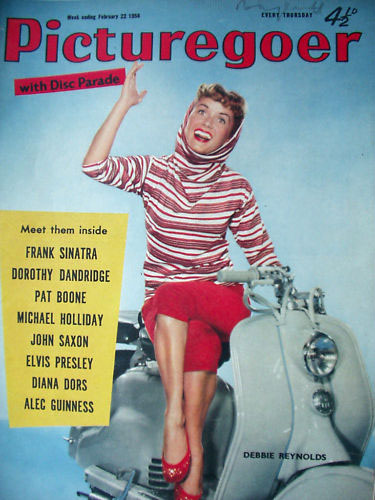
Debbie Reynolds on a Lambretta 150 Mk11 Id on the cover of the February, 1958 issue of Picturegoer Magazine. From Picturegoer Online.

Another view from the Picturegoer cover photo shoot. Personally, I think that this is a better choice than the one that made it on the cover. From jeanjeanie61's website fookdamorph.
While the one from the 1966 movie The Singing Nun is a light blue Innocenti Lambretta Li 125:
Debbie Reynolds on a Lambretta Li 125 in the 1966 movie The Singing Nun. From http://www.movieposters.ha.com.
Not that I can tell the difference. Lambretta experts feel free to comment.
Then there is the The Singing Nun medium gray Lambretta 150 LI Special that was on display in the now-defunct Buena Park, California Movieland Wax Museum collection: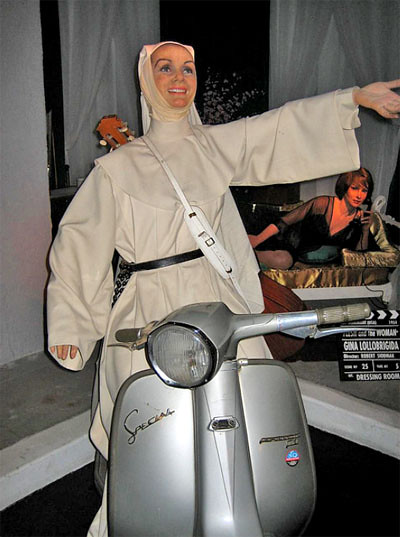
A waxen Debbie Reynolds on a Lambretta 150 LI Special from the defunct California Movieland Wax Museum. From jamesandtim.
After spending much time there with a wax nun on board, it sold for $1,050, sans engine and Debbie, at their liquidation auction in 2006.

A derelict Lambretta 150 LI Special at the California Movieland Wax Museum auction. From icollector.com.

The engineless Lambretta as sold at the California Movieland Wax Museum auction. From icollector.com.
It was rumored to be in the Phoenix, Arizona Hard Rock Hotel collection, but a couple of scooter enthusiasts bought it, so I doubt that since it’s not on the Hard Rock's searchable memorabilia list.
I’ve read that Jeanine Deckers (aka Sister Luc Gabriel , aka Sister Smile, aka Luc Dominique), the real Singing Nun, didn’t really drive a scooter. I remember being taught the English version of the song Dominique in school. That sure wouldn't happen today.
Now the Singer roadster. This photograph was taken by Frank Worth on, I believe, the same day that the April, 1953 cover photo shoot above was taken at the same 20th Century Fox Studios parking lot:

A frilly Debbie Reynolds leaps for joy in front of Donald O’Connor and a Singer SM 1500 Roadster. Frank Worth photograph taken circa April, 1953 in the 20th Century Fox Studio parking lot. From the Divine Marilyn Monroe blog.
I’m not sure whether this is O’Connor’s or Reynolds’ car - the whitewalls tilted me towards Debbie at first – but then, the striped two-tone paint job and that racing helmet in Donald’s hand has me leaning the other way. The latest O’Connor and Reynolds film, MGM’s I Love Melvin, had just been released in March. (Interesting bit of trivia on that film from Lileks.) Reynolds would go on to make two more MGM musicals that year. I couldn’t find a picture of Donald O’Connor on a scooter.
Updated 03/06/12: Second picture down added.
Since I posted Katharine on a scooter and in a Singer, here’s Debbie Reynolds on a scooter and, um, next to a Singer. While Kate cruised on a Vespa, Debbie went with two different Lambrettas. I am told that the first - on the cover of the February, 1958 issue of Picturegoer Magazine - is a 150 Mk11 Id:


While the one from the 1966 movie The Singing Nun is a light blue Innocenti Lambretta Li 125:

Not that I can tell the difference. Lambretta experts feel free to comment.
Then there is the The Singing Nun medium gray Lambretta 150 LI Special that was on display in the now-defunct Buena Park, California Movieland Wax Museum collection:

After spending much time there with a wax nun on board, it sold for $1,050, sans engine and Debbie, at their liquidation auction in 2006.


It was rumored to be in the Phoenix, Arizona Hard Rock Hotel collection, but a couple of scooter enthusiasts bought it, so I doubt that since it’s not on the Hard Rock's searchable memorabilia list.
I’ve read that Jeanine Deckers (aka Sister Luc Gabriel , aka Sister Smile, aka Luc Dominique), the real Singing Nun, didn’t really drive a scooter. I remember being taught the English version of the song Dominique in school. That sure wouldn't happen today.
Now the Singer roadster. This photograph was taken by Frank Worth on, I believe, the same day that the April, 1953 cover photo shoot above was taken at the same 20th Century Fox Studios parking lot:

I’m not sure whether this is O’Connor’s or Reynolds’ car - the whitewalls tilted me towards Debbie at first – but then, the striped two-tone paint job and that racing helmet in Donald’s hand has me leaning the other way. The latest O’Connor and Reynolds film, MGM’s I Love Melvin, had just been released in March. (Interesting bit of trivia on that film from Lileks.) Reynolds would go on to make two more MGM musicals that year. I couldn’t find a picture of Donald O’Connor on a scooter.
Monday, August 08, 2011
Different Hepburn, different Vespa
Updated 8/22/11
For those of you who googled 'Hepburn' and 'Vespa' and expected Audrey, here you go:

Audrey Hepburn on a Vespa, possibly in London, date unknown. From Kim Kelley's blog Bella Rustica.
But - not from Roman Holiday as a few other websites state. That movie takes place in, well, Rome. The license on this scooter is British, and if this is not a one-way street, those cars in the background are driving on the left side of the road. Besides, this Vespa is newer and a different model than the one from the movie seen here:

My favorite shot of Audrey Hepburn on a Vespa, from the aforementioned 1953 movie Roman Holiday. From The Nifty Fifties Audrey Hepburn pages.
Nor is it the one from another Audrey Hepburn film - this one from 1957 and co-starring Gary Cooper, Love in the Afternoon. This time the Vespa is plying the streets of Paris, but Audrey is not driving:

Vespa in Paris. Screenshot from 1957 movie Love in the Afternoon. From the Van Nuys, California vintage Italian scooter maven Kara Snow's old website The San Diego Times.
Love in the Afternoon is not as scooterific as Roman Holiday is however. In fact, the only other scooter you'll see is this Lambretta LC 125 posing with a late '30s Citroen Traction Avant and a couple of back-to-back Renault 4CVs - and both scooter shots are in the first five minutes of the movie:

Lambretta LC 125 in Paris. Screenshot from 1957 movie Love in the Afternoon.
So, does anyone know where/when/why the top photo was taken?
Audrey Hepburn trivia: After she completed dance school in 1944, Audrey Hepburn formed a dance troupe. She secretly funneled all the proceeds to the Dutch Underground.
For those of you who googled 'Hepburn' and 'Vespa' and expected Audrey, here you go:

But - not from Roman Holiday as a few other websites state. That movie takes place in, well, Rome. The license on this scooter is British, and if this is not a one-way street, those cars in the background are driving on the left side of the road. Besides, this Vespa is newer and a different model than the one from the movie seen here:

Nor is it the one from another Audrey Hepburn film - this one from 1957 and co-starring Gary Cooper, Love in the Afternoon. This time the Vespa is plying the streets of Paris, but Audrey is not driving:

Love in the Afternoon is not as scooterific as Roman Holiday is however. In fact, the only other scooter you'll see is this Lambretta LC 125 posing with a late '30s Citroen Traction Avant and a couple of back-to-back Renault 4CVs - and both scooter shots are in the first five minutes of the movie:

So, does anyone know where/when/why the top photo was taken?
Audrey Hepburn trivia: After she completed dance school in 1944, Audrey Hepburn formed a dance troupe. She secretly funneled all the proceeds to the Dutch Underground.
Friday, August 05, 2011
Caribbean Kate and the Singer Saga
Updated 8/13/11
Whether it's a Vespa she's tooling around on in London or a Singer roadster in Jamaica, Katharine Hepburn gets photographed with some pretty cool vehicles. First the Vespa:

Katharine Hepburn leaving Shepperton Studios during filming in London in 1956. From Jesse's Hepburn/Vespa post
Go to Just A Car Guy's blog post for the story and more pics. The third photo down shows her with wardrobe man Johnny Hilling on the set of The Iron Petticoat, filmed in England by London Film Productions in 1956 for MGM. The movie, which starred Bob Hope and Katharine Hepburn, premiered in Berlin, West Germany on June 30, 1956 and was released in the U.S. on January 7, 1957. The film is also known as Not for Money.
As for the Singer, the classy website The Nifty Fifties is a daily must-go-to for me, and if Vanessa hadn't recently posted the picture below, I'd most likely would never have come across it even though the picture has apparently been kicking around the intertubes since at least 2008 and is on dozens of other sites:
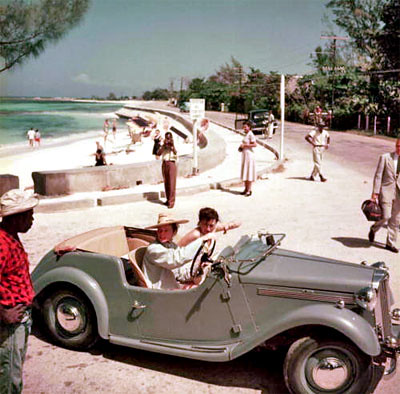
Katharine Hepburn and Irene Mayer Selznick in a Singer SM 1500 Roadster. Taken circa September, 1952 at Montego Bay, Jamaica. From The Nifty Fifties.
The photo by Slim Aarons (whose self-portrait is captured in the hubcaps) of Katharine Hepburn and her friend and passenger Irene Mayer Selznick (daughter of Louis B. Mayer and ex-wife of David O. Selznick) is said to have been taken in 1953. Kate and Irene are seen stopped along Montego Bay's waterfront in Jamaica. Whenever Katharine vacationed in Jamaica she liked to stay at the estate of Noel Coward (now an inn) which was just over a couple of hours east along the coast from Montego Bay. I believe the original photo traces back to this page from this collection.
Now here is where the story of the roadster gets interesting. In her 1989 book A Remarkable Woman: A Biography of Katharine Hepburn, Anne Edwards wrote about a trip Hepburn took to Jamaica in September, 1952 in-between her London and New York performances in George Bernard Shaw's The Millionairess. While the set and cast of the play sailed to New York, Hepburn and Selznick flew to Jamaica to vacation a few days at the Coward estate. Edwards wrote that "The two women arrived in an open sports car - unheard of in Jamaica and apparently shipped in by either Kate or Irene." Edwards goes on to say "Up until that time, Noel had firmly warned of the danger of sunstroke and on the insistence of his Jamaican friends had used a closed car. From that point on, he followed Kate's lead and always drove about in an open car on the island..." (Emphasis mine.) In all probability it was Kate who imported the car. She had spent some of her off time in London shipping antiques back home - certainly she could have arranged to buy a car and have it sent to Jamaica. However, it seems more likely that it wasn't a new car shipped from England at all, but her own personal roadster shipped from New York.
William Vaughan was an erstwhile Broadway actor - a decade earlier, when the actor he replaced got drafted, Vaughan went overnight from bit-part to leading man in Counsellor-at-Law at the Royale Theater, while the next block over Katharine Hepburn was starring in Without Love at the St. James Theater. Later he turned car dealer, wannabe car maker, and sometimes amateur race driver. In 1952 he had the exclusive Singer distributorship with his own dealerships in New York:

and Hollywood:

Vaughan was not above using celebrities to sell cars. The likes of Donald O'Connor, Debbie Reynolds, Sammy Davis Jr. and Marilyn Monroe were seen in - or on - them (see more posts above).
This 1950 advertising handout featured Lucille Ball, in conjunction with her and Desi's new act at the Roxy Theater, in a Singer Nine roadster:

Lucille Ball in her Singer Nine Roadster on the sidewalk outside the Roxy Theater, New York City circa June, 1950. From Singer Period Advertisements.
On the back is the ad copy ginned up by Vaughan Motors:

From Singer Period Advertisements.
Living in Connecticut, Kate would have bought her 1951-52 Singer SM 1500 Roadster (4AD) from Vaughan's New York dealership. Well, it could be a 1952 4AB, since the last 250 of those built had the same outside skin as the 4AD, but with the 4AB mechanics underneath. Some Singer aficionado please help me out here. Kate's example was delivered without trafficators, which would have been in the bodywork just behind the door as seen on the Singer Nine in the above ad.
I can find no account (although I haven't looked all that hard yet) of Kate taking a Jamaican vacation in 1953. So, is this picture from the late 1952 trip? Did Slim Aarons simply wait a few months before copyrighting it in 1953? Did Kate and Irene go back to the island after the New York run of The Millionairess - which ended on December 28, 1952 - and greet the New Year on Montego Bay? Who knows? Suffice to say that Slim Aarons, either intentionally or inadvertently, captured for posterity the first roadster in Jamaica, and it's a Singer!
For a concise yet brilliant history of Singer Motors, see History of the Singer Car by Kevin Atkinson, from The North American Singer Owners Club website.
For a look at Bill Vaughan's Vaughan-Singer Special, see the story at Forgotten Fiberglass website. To see other Singer Specials, go here.
Whether it's a Vespa she's tooling around on in London or a Singer roadster in Jamaica, Katharine Hepburn gets photographed with some pretty cool vehicles. First the Vespa:

Go to Just A Car Guy's blog post for the story and more pics. The third photo down shows her with wardrobe man Johnny Hilling on the set of The Iron Petticoat, filmed in England by London Film Productions in 1956 for MGM. The movie, which starred Bob Hope and Katharine Hepburn, premiered in Berlin, West Germany on June 30, 1956 and was released in the U.S. on January 7, 1957. The film is also known as Not for Money.
As for the Singer, the classy website The Nifty Fifties is a daily must-go-to for me, and if Vanessa hadn't recently posted the picture below, I'd most likely would never have come across it even though the picture has apparently been kicking around the intertubes since at least 2008 and is on dozens of other sites:

The photo by Slim Aarons (whose self-portrait is captured in the hubcaps) of Katharine Hepburn and her friend and passenger Irene Mayer Selznick (daughter of Louis B. Mayer and ex-wife of David O. Selznick) is said to have been taken in 1953. Kate and Irene are seen stopped along Montego Bay's waterfront in Jamaica. Whenever Katharine vacationed in Jamaica she liked to stay at the estate of Noel Coward (now an inn) which was just over a couple of hours east along the coast from Montego Bay. I believe the original photo traces back to this page from this collection.
Now here is where the story of the roadster gets interesting. In her 1989 book A Remarkable Woman: A Biography of Katharine Hepburn, Anne Edwards wrote about a trip Hepburn took to Jamaica in September, 1952 in-between her London and New York performances in George Bernard Shaw's The Millionairess. While the set and cast of the play sailed to New York, Hepburn and Selznick flew to Jamaica to vacation a few days at the Coward estate. Edwards wrote that "The two women arrived in an open sports car - unheard of in Jamaica and apparently shipped in by either Kate or Irene." Edwards goes on to say "Up until that time, Noel had firmly warned of the danger of sunstroke and on the insistence of his Jamaican friends had used a closed car. From that point on, he followed Kate's lead and always drove about in an open car on the island..." (Emphasis mine.) In all probability it was Kate who imported the car. She had spent some of her off time in London shipping antiques back home - certainly she could have arranged to buy a car and have it sent to Jamaica. However, it seems more likely that it wasn't a new car shipped from England at all, but her own personal roadster shipped from New York.
William Vaughan was an erstwhile Broadway actor - a decade earlier, when the actor he replaced got drafted, Vaughan went overnight from bit-part to leading man in Counsellor-at-Law at the Royale Theater, while the next block over Katharine Hepburn was starring in Without Love at the St. James Theater. Later he turned car dealer, wannabe car maker, and sometimes amateur race driver. In 1952 he had the exclusive Singer distributorship with his own dealerships in New York:

and Hollywood:

Vaughan was not above using celebrities to sell cars. The likes of Donald O'Connor, Debbie Reynolds, Sammy Davis Jr. and Marilyn Monroe were seen in - or on - them (see more posts above).
This 1950 advertising handout featured Lucille Ball, in conjunction with her and Desi's new act at the Roxy Theater, in a Singer Nine roadster:

On the back is the ad copy ginned up by Vaughan Motors:

Living in Connecticut, Kate would have bought her 1951-52 Singer SM 1500 Roadster (4AD) from Vaughan's New York dealership. Well, it could be a 1952 4AB, since the last 250 of those built had the same outside skin as the 4AD, but with the 4AB mechanics underneath. Some Singer aficionado please help me out here. Kate's example was delivered without trafficators, which would have been in the bodywork just behind the door as seen on the Singer Nine in the above ad.
I can find no account (although I haven't looked all that hard yet) of Kate taking a Jamaican vacation in 1953. So, is this picture from the late 1952 trip? Did Slim Aarons simply wait a few months before copyrighting it in 1953? Did Kate and Irene go back to the island after the New York run of The Millionairess - which ended on December 28, 1952 - and greet the New Year on Montego Bay? Who knows? Suffice to say that Slim Aarons, either intentionally or inadvertently, captured for posterity the first roadster in Jamaica, and it's a Singer!
For a concise yet brilliant history of Singer Motors, see History of the Singer Car by Kevin Atkinson, from The North American Singer Owners Club website.
For a look at Bill Vaughan's Vaughan-Singer Special, see the story at Forgotten Fiberglass website. To see other Singer Specials, go here.
Subscribe to:
Comments (Atom)
